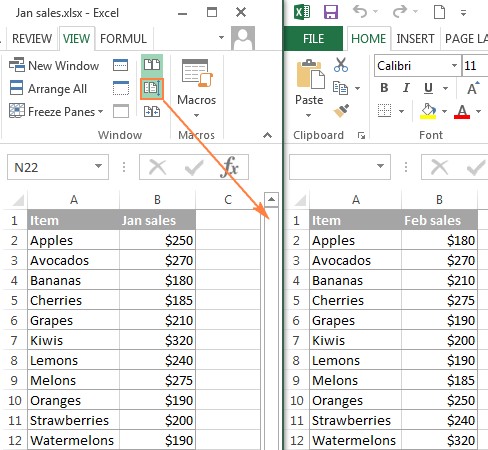Comparing two Excel worksheets to identify differences is a common task for many professionals. Whether you’re tracking sales data, managing inventory, or reconciling financial records, knowing how to efficiently compare worksheets can save you time and effort. This article explores various methods for comparing Excel files and pinpointing discrepancies, from simple visual inspections to leveraging powerful built-in features and third-party tools.
Quick Comparison Techniques for Excel Worksheets
For smaller datasets and straightforward comparisons, Excel offers several quick and easy methods:
View Side-by-Side Comparison
Excel’s “View Side by Side” feature allows you to visually compare two workbooks or two sheets within the same workbook. This is particularly helpful for spotting obvious differences in values or formatting.
- Open both Excel files.
- Navigate to the View tab, then the Window group, and click View Side by Side.
- Enable Synchronous Scrolling to scroll through both worksheets simultaneously.
- Use the Arrange All option to organize multiple Excel windows vertically or horizontally.
Comparing Two Sheets in the Same Workbook
To compare sheets within the same workbook:
- Open the Excel file.
- Go to View > Window > New Window.
- Enable View Side by Side and select the desired sheets in each window.
Identifying Differences in Values Using Formulas
For a more automated approach, use a simple formula to highlight differences in cell values:
- Create a new worksheet.
- In cell A1, enter the formula:
=IF(Sheet1!A1 <> Sheet2!A1, "Sheet1:"&Sheet1!A1&" vs Sheet2:"&Sheet2!A1, ""). - Drag the fill handle down and across to apply the formula to the entire data range. This formula compares corresponding cells in two sheets and displays discrepancies.
Highlighting Differences with Conditional Formatting
Visualize differences directly within a worksheet using conditional formatting:
- Select the data range in the worksheet where you want to highlight differences.
- Go to Home > Styles > Conditional Formatting > New Rule.
- Create a new rule using the formula:
=A1<>Sheet2!A1. - Choose a formatting style to highlight the differing cells.
Advanced Comparison Methods and Tools
For complex comparisons involving formulas, formatting, or large datasets, consider these advanced options:
Compare and Merge Workbooks for Shared Files
This built-in feature is ideal for merging changes from multiple users working on a shared workbook:
- Enable the Compare and Merge Workbooks feature through the Quick Access Toolbar customization.
- Open the primary workbook and use the Compare and Merge Workbooks command to select the copies you want to merge.
- Review the merged changes using the Track Changes feature on the Review tab.
Third-Party Comparison Tools for Excel
Several third-party tools offer robust comparison capabilities, including:
- Synkronizer Excel Compare: Provides comprehensive comparison, merging, and updating features.
- Ablebits Compare Sheets: Offers a user-friendly wizard-driven interface with multiple comparison algorithms and intuitive review and merge functionalities. Allows customization of highlighting and filtering options.
- xlCompare: Compares workbooks, worksheets, names, and VBA projects, identifies various types of differences, and facilitates merging.
- Change pro for Excel: Enables comparison on desktop and mobile devices, detects changes in formulas, values, and layout, and generates comprehensive reports.
Conclusion
Excel offers a range of methods to compare worksheets and identify differences. Choosing the right technique depends on the complexity of your data and your specific needs. For quick visual comparisons, the side-by-side view is sufficient. For identifying discrepancies in values, formulas or conditional formatting can be utilized. For more in-depth analysis and merging of changes, especially in shared workbooks or complex datasets, consider leveraging the power of dedicated comparison tools. By mastering these techniques, you can streamline your workflow and ensure data accuracy in your Excel projects.
